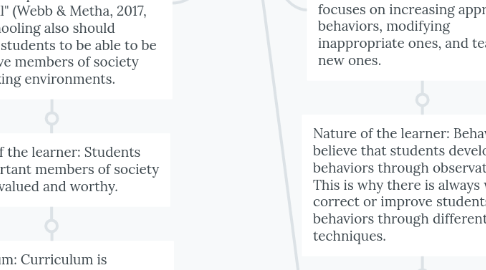
1. Purpose of schooling: It is believed that "...schooling is to teach the universal and eternal truths, cultivate the rational intellect, and develop the spiritual nature of the individual" (Webb & Metha, 2017, p.72). Schooling also should promote students to be able to be productive members of society and working environments.
1.1. Nature of the learner: Students are important members of society who are valued and worthy.
1.1.1. Curriculum: Curriculum is expected to include subjects such as: philosophy, history, mathematics, languages, litertaure, political science, geography, sociology, scienes, and fine arts (Webb & Metha, 2017). These subjects are important in creating well rounded students. Perennialists believe that these subjects will help students in developing intellect in other aspects of life. Another emphasis is creating content that includes developing students character and moral training.
1.1.1.1. Instructional Methods: There are three different methods of instruction: didactic instruction, coaching, the Socratic method. It is also believed that students must be taught critical thinking and questioning strategies before any subjects. These tecahing methods have been chosen in order to develop students knowledge at the highest level.
1.1.1.1.1. Classroom management: Perennialists believe that teachers must provide students with discipline in order to create a structured environment. They believe this is the best way to organize a classroom in order to reinforce time, precision, and order.
2. Purpose of schooling: The purpose of schooling is focus on students behaviors. Behaviroism focuses on increasing approprite behaviors, modifying inappropriate ones, and teaching new ones.
2.1. Nature of the learner: Behaviorist believe that students develop behaviors through observation. This is why there is always ways to correct or improve students behaviors through different techniques.
2.1.1. Curriculum: Behaviorist curriculum is centered around creating assignments that develop students belief systems, recognizing how they influence their environment, and creating critical thinking skills. This is done in order to create behavioral objectives and cognitive skills. They believe that teaching materials, instructional methods, and behavioral objectives would be the most effective because they directly influence students behaviors (Webb & Metha, 2017).
2.1.1.1. Instructional Methods: There are a variety of different instructional methods behaviorist that include: programmed learning, resources that provide feedback/reinforcement, computer based learning, and socioemotional assignments. It is believed that a combination of these methods will provide opportunities for students to learn how to respond appropriately and develop skills that need to accomplish certain skills.
2.1.1.1.1. Classroom management: Classroom structure is one of the most important aspects in behaviorism. Creating rules and routines for students will reinforce expectations that students will need to follow. This will allow teachers to identify certain behaviors in their students because they will have time to observe their students. Another aspect that is important is classroom communication. Creating a dialogue with students will help showcase expected behaviors and inappropriate behaviors.
